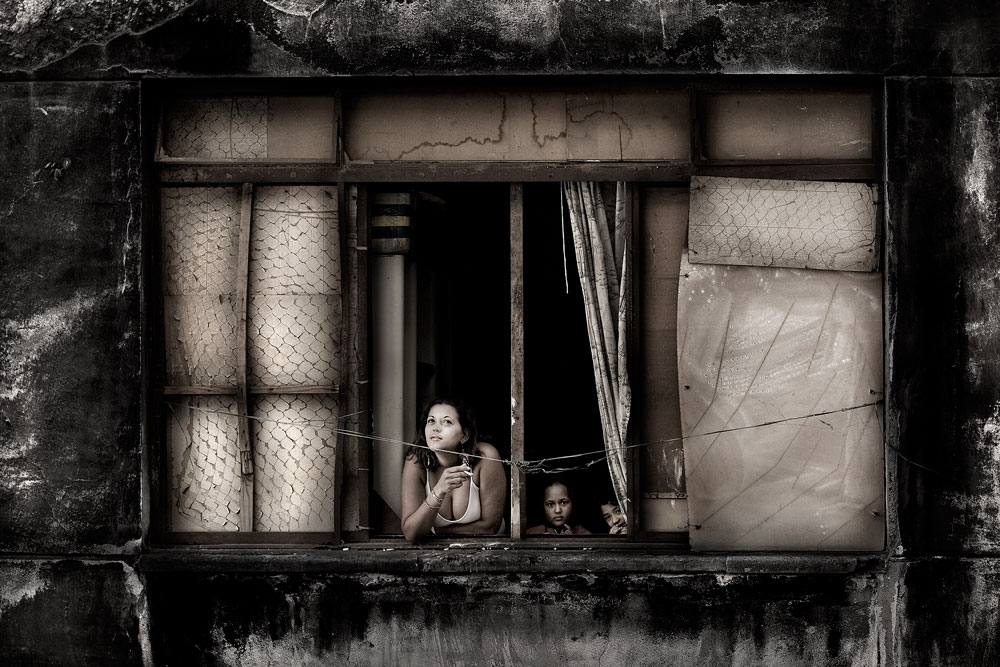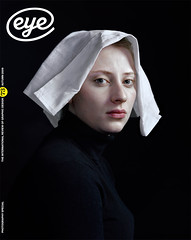Autumn 2009
The view from here
Julio Bittencourt records the last days of Prestes Maia 911 in São Paulo, Brazil.

In 2002, a disused building in downtown São Paulo was squatted by a homeless collective – hundreds of families. However in the summer of 2007, after years of threats and, eventually, a few concessions, the last inhabitant was evicted and the lower parts of its two linked tower blocks sealed with concrete.
In its last year or so, Brazilian photographer Julio Bittencourt documented its tenants, one window at a time, in a series of digital pictures taken from one block to the other. These have been published (In a window of Prestes Maia 911 Building, Dewi Lewis, 2008) and exhibited in New York, Berlin and elsewhere.
Some of Bittencourt’s flat-dwellers hover indoors, attendant on some domestic task, only half visible, like carp in a still pond; others embrace, chat to unseen neighbours or gaze listlessly outwards. The boards put over the windows to secure the building are still often partly in place, creating snarling gaps in the severe compositional rectangle which frames each picture.
There has been some interesting online traffic about Bittencourt’s project. One blogger says that in emphasising the ordinary, domestic humanity of his subjects, he dishonoured the way they stood together against the state’s attempts to prise them out: that the personal is not political, or not political enough. But there is nothing ordinary about Bittencourt’s pictures. Stylised and moody, they speak of decay and fate. Dark tones, strong contrasts, muted, diseased colours – the work is as many degrees away from the bleak certainties of social realism as it is from the West’s jollified, sambas-and-swimwear image of Brazil.
All photographs from In the window of Prestes Maia 911 Building by Julio Bittencourt, Dewi Lewis Publishing, 2008.
In some renderings of Bittencourt’s project, individual ‘windows’ are tiled together to make large composites. These have a kind of abstract beauty (and here at least – seeing such a quality in a document, however partial, of poor people’s lives – we would be wise to tread carefully).
But they also open up a curious and powerful conceptual space between the repeated elements – the identical windows, identically framed – and the divergent ones – the people, their curtains, their stuff. There’s an effect of pixellation, a large image made out of countless small ones. There is also, in the hard grid arrangement,
a clear nod towards Modernism at its most hygienic and rational. Yet, just as clearly, the Prestes Maia 911 building is no Modernist utopia – again, notwithstanding the West’s fondness for the Brasilia, and the Braziliana, of Oscar Niemeyer.
Bittencourt’s ‘multiples’ read like a critique of Andreas Gursky’s seamless digital collages in which vast washes of people flow easily, unresistingly, through ordered, streamlined spaces – the spaces of power, money, technology and leisure, the spaces of a promised future. This, Bittencourt and his paulistanos seem to tell us, is where that future leads us. I can’t quite see what’s not political about that.
First published in Eye no. 73 vol. 19 2009
Eye is the world’s most beautiful and collectable graphic design journal, published quarterly for professional designers, students and anyone interested in critical, informed writing about graphic design and visual culture. It is available from all good design bookshops and online at the Eye shop, where you can buy subscriptions, back issues and single copies of the latest issue.


